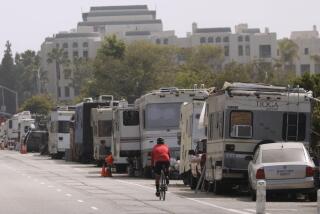Vacant Lots Termed Full of Promise as Gardens, Parks : Neighborhoods: Long Beach task force’s ‘Dirt to Turf’ manual tells how to turn eyesores into urban oases.
Laurel Howat believes vacant lots can be more than just patches of dirt, weeds and trash. Instead, she envisions community gardens, tot lots and mini-parks on these undeveloped areas throughout Long Beach.
Howat is chairwoman of the city’s Vacant Lot Task Force, a citizens’ committee that spent the past year determining the number of vacant lots in the city and studying ways to put them to good use.
The task force has produced “Dirt to Turf,” a 30-page manual filled with advice and step-by-step guidelines for transforming neighborhood blemishes into temporary urban oases.
The nine-member task force submitted the manual to the City Council’s Housing and Neighborhoods Committee. If approved, the manual will be distributed to neighborhood associations, owners of vacant lots, churches, schools, businesses and other groups interested in improving vacant lots.
“We’re not against vacant lots,” Howat said as she surveyed a deserted area covered with short grass near her Second Street home. “We’re just trying to get rid of some blight and increase a sense of community.”
*
The number of privately owned vacant lots fluctuates as new buildings go up and older ones are demolished, but currently there are about 400, Howat said. The city and its Redevelopment Agency also own numerous empty lots, but no one at City Hall knows exactly how many.
Vacant lots range in size from about 2,000 square feet to several acres. They can be found throughout the city, from the Ocean Avenue bluffs to heavily industrial North Long Beach. Some of the largest concentrations are in and around downtown and along Long Beach and Atlantic boulevards.
An empty lot at the northeast corner of Third Street and Chestnut Avenue--a block from the Civic Center--is filled with trash and knee-high weeds. A well-used footpath slices diagonally through the parcel. Nearby, a grimy mattress rests in a weed-infested lot at Third and Magnolia Avenue.
Task force members say they worry that these and other vacant lots attract vagrants, street peddlers, drug abusers and drug dealers and mar the appearance of surrounding properties. “They’re a blight on the entire neighborhood,” said member Joan Pladson.
Although a city ordinance requires all property owners to clear their land of weeds, trash and debris, officials say they rely heavily on property owners to comply voluntarily. The city sends reminders three times a year and cleanup orders every spring. If owners fail to comply--and between 25% and 40% don’t--the city cleans up the lots and bills the owners.
But Pladson says the process is a “horrible administrative nightmare.” Once the city orders an owner to clean up a vacant lot, the owner can appeal to the city’s Board of Examiners, Appeals and Condemnation.
“Weeks and months go by before they’re cleaned up, and a few weeks later the process starts all over again,” she said.
Howat said, however, that residents can do something about unsightly vacant lots, if they gain the cooperation of owners.
*
More than half of the 61 owners of vacant lots who responded to a task force survey were willing to let neighborhood groups temporarily use their land, she said.
Helen Woo has permitted a local group to turn part of her vacant lot at the northeast corner of First Street and Elm Avenue into a community garden. “I don’t plan to build anything on it in the near future,” she said. “I think (a community garden) is a wonderful idea. It beautifies the place and keeps the weeds out.”
Councilman Alan S. Lowenthal, who chairs the council’s Housing and Neighborhoods Committee, praised the task force’s work. “They’ve taken something that people complain about and dealt with the nitty-gritty details,” he said. “They’ve done an extensive amount of work on their own with little city support.”
Lowenthal became the leading advocate on the council to create the task force, but credits former Councilman Ray Grabinski with the original proposal. “He was a longtime champion of the city doing something about vacant lots,” Lowenthal said.
The number of vacant lots in Long Beach has grown so steadily over the past 15 years that some residents have become apathetic, Grabinski said. “But they lower the quality of life for everyone who lives around them,” he added.
Some of the ugliest vacant lots belong to the Redevelopment Agency, the former councilman said. “They won’t tell you how many they have because they don’t take care of them.”
Barbara Kaiser, the city’s redevelopment manager, said the agency has hired a private company to keep its lots free of weeds, trash and debris. “As far as I can tell, they’re well maintained,” she said.
The task force manual offers a long list of temporary uses for vacant lots, from building gazebos, terraces and playgrounds to planting grass and setting out benches.
“We want each neighborhood to come up with their own uses--and it doesn’t have to be anything special,” Pladson said.
More to Read
Sign up for Essential California
The most important California stories and recommendations in your inbox every morning.
You may occasionally receive promotional content from the Los Angeles Times.









